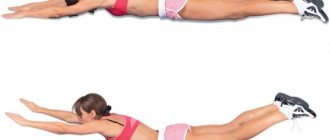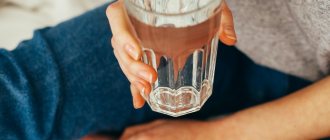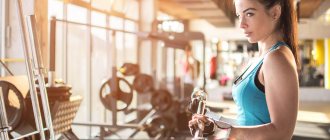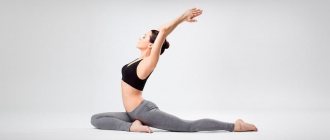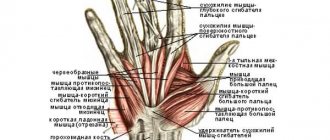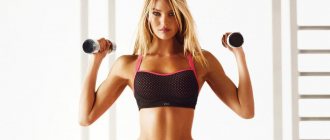It is known that the strength of a chain is determined by the strength of its weakest link. Human skeletal muscles can also be compared to a chain that has a weak link: this is the stabilizing muscles of the middle of the body. If this area lags behind in its development, the athlete cannot avoid injuries.
Problems with the lower back, sprains and tears in the abdominal muscles when working with heavy (and sometimes not very heavy) weights - all this, unfortunately, is common for those who do not pay enough attention to training the core muscles, which will be discussed in this article.
Dynamic bar
This is one of the many versions of the bar, but in dynamics. This exercise can work almost your entire core in a short period of time—according to Richard Wilcock, the dynamic plank works 6 different core muscle groups.
Technique:
- Stand in a regular elbow plank position with your forearms on a ball (preferably an exercise ball).
- Keeping your core engaged and your body still, begin rolling the ball in a small clockwise circle using your hands. 1 round – 1 rep.
Do the required number of repetitions.
Core exercises[edit | edit code]
Beginner level
- Pelvic lift
- Twisting
- Medicine ball throw
- Plank
- Medicine ball throw up
- Extensor
- Lumberjack with medicine ball
- Climber steps
- Side throw
Advanced level
- Leg Raise
- Raising the body with emphasis on the elbows
- Good morning exercise on one leg with weights
- Saw
- Leg raise with ball
- Turkish Rise
- Rowing
- Raising the pelvis with support on one leg
- Rowing with push-ups
- Weighted crunch
- Windmill
- Moving with the ball
- Scorpion
- Turkish squats with kettlebell
- Knee lift
- Feet to the bar
Professional level
- Medicine ball push-ups
- corners
"Bird Dog"
This exercise comes from yoga. It involves almost the entire body and is aimed at finding balance. According to certified trainer and Aaptiv (fitness app) head instructor Jaime McPhaden, bird dog is a healthy, low-impact exercise that helps improve stability and coordination without putting too much pressure on your joints.
Technique:
- Get on all fours, knees at a 90-degree angle, hands under your shoulders. Remember to keep your abs tense and your back straight.
- Extend your right arm straight out in front of you and at the same time move your left leg back.
- Complete the movement by connecting your right elbow with your left knee under your body. Return to the starting position and repeat the same with your left arm and right leg.
Do the required number of repetitions.
see also
17 real weight loss tips from people who have lost more than 20 kg
Gluteal bridge
“Weak core muscles are often associated with weak gluteal muscles,” noted trainer Jaime, already familiar to us. According to the expert, this is an ideal exercise that you can do not only in the gym but also at home to strengthen your hamstrings and buttocks.
Technique:
- On the mat, lie on your back with your knees bent and your feet flat on the floor. Keep your heels directly under your knees. Place your arms at the sides of your body, palms down.
- Push off with your heels, straining your buttocks and abdominal muscles, lift your pelvis as high as possible.
- Hold at the maximum point for a few seconds, making sure that your spine does not round and your pelvis does not sag.
- Return to the starting position.
Do the required number of repetitions.
What muscles make up the core and where are they located?
The core muscles are located in the middle part of the human body, in the vertebral and hip regions. Despite the fact that part of the muscle group is located on the surface (for example, the abs), the core muscles are classified as a deep type.
Core muscle location
Fitness trainers recommend that every athlete, regardless of his age and physical fitness, strengthen his core, since this muscle group is officially recognized as the center of muscular activity of the body.
On the stomach
The core muscles located in the abdominal area include:
- The rectus muscles are located in the medial region of the peritoneum . It is the condition of this part of the muscles that directly affects the presence or absence of “packs” on the stomach of a particular person;
- The transverse muscle is a muscle bundle located transversely on the sides of the rectus muscles.
On the back
The core muscles located on the back include:
- back extensors (these muscles are leading when an athlete performs various types of deadlifts - deadlifts, deadlifts, and so on);
- coracobrachialis muscle (is a flat muscle located under the head of the biceps brachii muscle);
- infraspinatus muscles (triangular, flat muscle located in the area of the deepening of the scapula).
On the buttocks
The muscles of the feed, located in the area of the lower extremities and buttocks, include:
- small and medium muscles of the buttocks (muscles belonging to the deep ones, which are located under the gluteus maximus muscle);
- adductor muscles (this group is made up of 3 types of muscles - long, short and large, which are located on the inner surface of the thigh);
- muscles of the back of the thigh (this group is formed by the biceps femoris, semitendinosus and semimembranosus muscles).
"Cot"
The “clamshell” will help strengthen the muscles of the hips and pelvic floor even for those who are still new to the world of fitness. The exercise evenly distributes the load between the muscles of the inner and outer thighs.
Technique:
- Lie on your side with one leg crossed over the other. Bend your knees at an angle of 45 degrees.
- Place your head on your forearm.
- Pull your stomach in, as if pulling your navel towards your spine.
- Keeping your feet touching, lift the knee of your top leg as high as possible. Try to make the movement only with your knee, without rotating your pelvis. Your bottom leg should not leave the floor.
- At the top, pause for one count, then return your leg to the starting position.
Repeat.
Training problems
Core stability training violates three important principles. The first of these is the principle of specificity .
Training conditions are of decisive importance; they must be adequate to the assigned tasks. We learn what we learn. Dr. Lederman's favorite example is a pianist. You don't become one by learning to play the banjo or lifting weights with your fingers. To become a good pianist, you need to learn to play the piano.
If a person is trying to achieve core stability (and he is often advised to do just such a set of exercises), there is no guarantee that he will be able to control their work while standing, running or lifting weights. Such control is achieved by other exercises (Fig. 3).
Figure 3.
The training conditions must match the tasks ahead. You need to learn to do exactly the movements that you need to perform, and in the appropriate position.
As an example, Lederman cites a study in which. Although they strengthened the muscles needed to sit on a large rubber balloon, it did not improve their running performance. There are no universal exercises for core stability; the complex should depend on the specific type of physical activity in which a person is engaged. Lederman advises dedicating your training to that very activity and not thinking about the core muscles - they will strengthen themselves properly.
The second problem is that a person, no matter what exercise he performs, concentrates on the work of the core muscles, and not on an external goal.
This advice even applies to everyday life: a person running after a bus or standing at the kitchen stove is advised to constantly think about the work of his TrA. The question is how long he can hold this thought.
In general, the advice to constantly monitor the work of the core is not suitable even for athletes. When a person is practicing a movement, it is better for beginners to focus on his technique (internal focus), for a more experienced athlete - on his goal (external focus). External focus improves performance. A tennis player or football player, when he hits the ball, . If he focuses on the technique of movement or the work of his abdominal muscles, he may not be satisfied with the result of the blow, even with impeccable execution technique. Constantly focusing on TrA work will only hinder the athlete's ability to master the movement. It's even .
What about patients who complain of back pain and come to the gym for rehabilitation? Let's say during physical education they need... The patient can be shown how to bend the knees correctly (internal focus) and advised to keep the weight close to the body between the knees (external focus). The second option provides precise, “muscle” instructions: focus on joint tension in the hamstrings and quadriceps, gently relax the glutes, allow the calf muscles to stretch, etc. This constant internal focus makes it extremely difficult to complete an otherwise simple task. And these instructions are similar to the requirement to always monitor the stability of the core.
The third problem is the economy of movement.
Constant tension in the abdominal and back muscles leads to additional energy consumption. In everyday activities, such expenses are tiring, and when playing sports they reduce performance. It is known that people who learn a new movement often have limbs. This situation continues until they learn to perform the exercise correctly. And cocontraction requires a lot of energy. The same energy losses are inevitable if you constantly strain your core muscles. In order to achieve this, mechanical work should be limited to what is necessary, and its efficiency should be brought closer to the minimum.
Pallof press
Side pulley forward press. This is a core strengthening exercise that also forces the body to minimize stress on the back during various body movements, such as squats or running.
Technique (in the gym):
- Attach a standard overhead pulley D-handle and position it at shoulder height. You can also use the bottom block.
- Standing with the left side of your body at the machine, grab the handle with both hands and move away from the block a few steps to feel the tension on the cable.
- Place your feet shoulder-width apart and bend your knees slightly. Hold the handle at mid-chest level - this will be the starting position.
- As you exhale, pull the cable with straight arms. The core muscles should be tense and engaged. Hold for 2 seconds before returning to the starting position.
Do 10 reps on each side.
General recommendations for core training
To strengthen your core muscles, it is important to focus on sensations, being aware of which muscles are working at the moment. For girls, core muscle training does not involve working with weights. In the future, both men and women can use the equipment. Exercises can be either static or dynamic.
Important! You can't train your core muscles every day.
The complex, including warm-up and stretching, should last no more than an hour.
- For beginners, all exercises are performed once with multiple repetitions.
- If you are prepared, you can perform the complex in 3 approaches.
- If the exercise is performed statically , it must be held for approximately 5-7 breathing cycles (1 cycle: inhale-exhale) or 30-60 seconds, depending on preparation.
- Dynamic exercises should be performed for 16, 24, 32 repetitions.
"Dead Bug"
The Dead Bug is a static exercise that targets the abdominal, back and thigh muscles. Doing it regularly will make it much easier to do other exercises that involve moving your legs and arms while keeping your abdominal and back muscles stationary but engaged.
Technique:
- Lie on the floor, bend your knees and lift them so that a right angle forms between your knees and hips.
- Extend your arms towards the ceiling.
- Reach your left leg with your right hand. Try not to lift your lower back off the floor.
- Pause and return to the starting position.
- Repeat with the other arm and leg.
Do the required number of repetitions.
see also
The Real Reasons Why Muscles Get Tired During Exercise
Exercises for the core muscles[edit | edit code]
“Methodological planning of a training program”
Scientific manual ed.
Professor L.P. Lysova, 2016 Main article: Training the core muscles (supporting muscles)
Each movement begins in the central part of the body. That is why the correct position of the torso and pelvis is a necessary condition for performing any movement. The absence or lack of stability of these body parts prevents the effective use of leg or arm strength. Therefore, the stability of the trunk and pelvis is an essential factor that has a significant influence on movement.
In the absence of a stable muscle corset in the area of the shoulder girdle, abdomen/back and hips, it is impossible to maintain the correct position of the torso. In this case, the movements of the arms and legs are blocked, since pendulum-like movements of the limbs can only be effectively performed if there is a strong support.
Remember
: Stability of the trunk and pelvis is a necessary condition for performing movements. It represents the basis of strength training in all sports disciplines.
Particular attention should be paid to the development of the following muscle groups:
- rectus and oblique abdominal muscles (m. rectus abdominis and mm. obliquus internus et externus);
- back muscles (i.e. erector spinae);
- muscles of the interscapular region (m. trapezius and mm. rhomboidei);
- gluteal muscles (m. gluteus maximus);
- abductor muscles of the legs (mm. abductores).
Targeted strengthening of the above muscles is carried out in combination with stretching the hip flexor muscles (m. iliopsoas), hip abductors (mm. adductores) and pectoral muscles (m. pectoralis major). Basic exercises for the development of these muscle groups can be performed anywhere and do not require any auxiliary equipment. We call them, depending on their intended purpose, athletics, sprinting, running, throwing, general physical or even football turns. The principle is extremely simple: the trainee makes one complete rotation around the longitudinal axis of the body and after each 90° rotation performs the appropriate exercise to develop strength.
Athletics turns[edit | edit code]
For optimal results, this exercise should be performed daily, beginning with the specialized training phase and independently of the training itself. You can increase the intensity of this exercise by performing not one, but two to five rotations (with a total of eight exercises) around the longitudinal axis of the body. Later, you can increase the load when introducing new exercise variations, using the Physioball and appropriate equipment for strength training.
1. Straight body lift to strengthen the rectus abdominis muscles
Initial position
- lying on your back, legs bent with emphasis on your heels, toes pulled towards you.
The lower back is pressed tightly to the floor. Stretch your arms parallel to your body forward towards your legs. Pull your stomach in and then lift your head first and then your torso, gradually increasing the amplitude of this movement until your shoulders are lifted off the floor. Next, either raise and lower your torso with short, small movements, or hold your torso in a raised position for some time (for example, 30 s). It is important to continue breathing slowly and calmly. Attention: it is strictly forbidden to fix your legs.
2. Lying on your side to strengthen the lateral abdominal muscles
Initial position
- lying on your side with emphasis on your forearm, your free hand rests on the side of your body. Both legs are straightened, toes are pulled towards you. Tighten your stomach and buttocks and lift your torso until your shoulder, hip and knee form a straight line. Hold this position for 30 seconds, then slowly return to the starting position. Stop the exercise when the pelvis falls forward.
3. Balance on one leg to strengthen the back extensors
In a position on all fours, horizontally raise your opposite leg and arm so that they are in a position parallel to the body, pull in your stomach and hold this position for 30 seconds. Then change arms and legs and repeat the exercise. Make sure that the pelvis does not fall to the side (both buttocks should be at the same height).
4. Side lying to strengthen the lateral abdominal muscles
This exercise is performed in the same way as exercise 2, but lying on the other side.
5. Bridge to strengthen the gluteal muscles
Initial position
- lying on your back, legs resting on the floor, arms parallel to the body, palms pressed tightly to the floor. Tighten your stomach and buttocks and lift your buttocks until your torso and thighs form a straight line. Hold this position for 30 seconds, then slowly return to the starting position. Attention: the cervical spine should be pressed firmly to the floor.
6. Leg abduction to strengthen the abductor muscles
Initial position
- lying on your side, lower leg bent at the hip, knee and ankle joints by 90°. The head rests on the lower arm, the upper arm lies in front of the body and supports it. Tighten your stomach and buttocks and lift your top leg, pulling your toes toward you. Next, either raise and lower your leg with short, small movements (it should not touch the lower leg), or hold your leg (for example, 30 s) in this position. When performing this exercise, the upper leg should not go forward.
7. Raising your arms to strengthen the muscles of the interscapular area
Initial position
- lying on your stomach, feet resting on the floor with your fingertips, hands lying on the floor, forming 90° with the line of the body. Raise your arms and lower them with short movements (with your hands not touching the floor) or hold them (for example, 30 s) in a raised position.
8. Leg extensions to strengthen the abductor muscles
This exercise is performed in the same way as exercise 6, but lying on the other side.
"A hundred"
“The Hundred” is a fairly simple but effective exercise that comes from Pilates. It is aimed at stabilizing the lumbar spine and strengthening the abdominal muscles. Daniela Caesar-Roden, a certified Pilates instructor at Old School Pilates, notes that it's important to pay attention to breathing, as the exercise also affects the diaphragm, which stabilizes the core muscles, especially during deep exhalations.
Technique:
- Lie on your back, place your arms along your torso, raise your legs and bend them at a right angle.
- Exhale and use your abdominal muscles to lift your upper body off the floor. Press your lower back to the floor by tensing your abdominal muscles and drawing in your abdomen.
- Raise your arms parallel to the floor and hold.
- Keeping your legs at right angles (or, if you want to complicate the exercise, at an angle of 45 degrees), begin to make up and down patting movements with tense hands, without bending your elbows or touching the floor. Do 5 beats on a long inhale and 5 beats on a long exhale. Remember to keep your core tense. You have completed 1 cycle. Over time, try to do up to 10 cycles.
Consequences of muscle weakness
Due to weakness and general underdevelopment of the muscular corset, it can:
- posture worsens. Due to the inability of the core muscles to take on part of the load, the body weight is distributed exclusively across the spine. Under excessive load, the spinal column bends, the person begins to stoop, the shoulders can shift to different levels of height;
- loss of ability to maintain balance;
- general flexibility of the body decreases;
- deterioration of the health of the circulatory, excretory, digestive systems, as well as reproductive organs (core muscles are of particular importance for women);
- change in a negative direction the appearance of a particular person, in particular the abs and buttocks (the body becomes more flabby, muscles weaken, skin elasticity is lost, cellulite may appear);
- there is a displacement of one or more internal organs from their natural place;
- the indicator of strength and endurance decreases (this factor is especially important for athletes who care not just about physical indicators, but also about the presence of “explosive” strength necessary to make jumps, strikes or perform plyometric exercises);
- the health of the spinal column, as well as joints and tendons, deteriorates (this can lead to the premature development of serious diseases, for example, osteoporosis, osteochondrosis, and so on).
Elbow plank
The classic plank is one of those exercises that involves and puts a lot of stress on the main muscles of our body. At first glance, the exercise may seem simple - but just try it!
Technique:
- Take a lying position, leaning on your forearms.
- Place your hands shoulder-width apart.
- Keep your body above the floor without lifting your pelvis up. The abs should be tense, the shoulders should be relaxed, and the back should remain straight. Your body should form a stationary line.
- Hold the position for as long as you can. Start with 20-30 seconds, gradually increasing the time to 1 minute.
see also
How to pump up your abdominal muscles with one forgotten wiper exercise
Self-test at home
How to understand and check yourself whether everything is okay with your muscles:
- Correct lumbar position . You should not have either hyperlordosis (a large arch in the lower back) or hypolordosis (when your back is completely flat).
- Rounding of the back and arching in the lower back during physical activity and, even more so, in everyday life.
- Flabby belly with no visible fat . If, when you retract, your stomach becomes visually much smaller, then most likely you have a weak transverse abdominal muscle.
- If you can't hold a plank for 30 seconds.
Side plank
The side plank is another effective exercise that strengthens the abdominal muscles without putting stress on the spine.
Technique:
- Lie on your left side. Lean on your left elbow, placing it directly under your left shoulder. Place your right foot on top of your left.
- Raise your hips up, transferring your body weight to the tips of your legs and forearms. The main load should fall on the core muscles.
- Pull your stomach in and tighten your abs.
- Stay in this position, focusing on your breathing.
Spiderman push-ups
This is a fairly complex strength exercise aimed at strengthening the pectoral muscles, triceps, deltoids and abdominal muscles.
Technique:
- Stand up straight with your arms outstretched. Place your hands shoulder-width apart. Tighten your abdominal muscles.
- As you lower yourself to a push-up position, draw your left knee toward your elbow.
- Pause, push up, then return to the starting position. Do the same with the other leg to complete one repetition.
Do the required number of repetitions.
Leg raises while lying on your back
Many trainers recommend this exercise to strengthen the abdominal muscles, especially in the lower part, because it is quite simple, but at the same time effective. Plus, it can be done anywhere.
Technique:
- Lie on your back with your legs raised towards the ceiling. The arms are extended along the body or clasped behind the head.
- While pressing your back, slowly lower both legs down without touching the floor.
- Slowly lift them back up.
Repeat.
Functions: what they are responsible for
- the most important: the core muscles help us maintain balance when walking upright,
- it is these muscles that correctly distribute the load when standing, walking, running, lifting weights, getting up, allowing the muscles of the upper and lower parts of the body to effectively interact with each other,
- they are also needed to fix the internal organs in the anatomically correct position,
- to maintain optimal intra-abdominal pressure,
- it is also insurance against hernias,
- performing complex coordination actions,
- these muscles make your stomach flat,
As you understand, we almost always need core muscles. Whether you need to stand up, stretch, get a saucepan from the top shelf, or “work” as a loader - the correspondent works everywhere here.
That is, roughly speaking, these muscles, although they do not move the bones, still ensure the correct position of the body during movement.
All of the above is very important to understand in order to properly train this muscle complex, and not make it worse!
In general, competent and high-quality core strengthening provides you with healthy posture and spine.
Mahi "Woodchop"
An exercise similar to the lumberjack movement engages the core muscles, causing them to resist side-to-side movement. The exercise is aimed at strengthening the abdominal muscles, especially the obliques.
Technique:
- Take a standing position. Feet slightly wider than shoulder width.
- Hold the dumbbell with both hands and lift it above your head, rotating your shoulders up to the right.
- Exhale and lower the dumbbell down diagonally across your body, ending behind your left hip.
- Return the dumbbell to the starting position.
Do the required number of repetitions.
Core stability can be detrimental
Constant tension in your core muscles can create and cause back pain. For chronic pain in patients when moving, which leads to further compression of the intervertebral discs.
affect the stability of the spine differently. Retracting the abdominal muscles was ineffective. Tension of these muscles increases spinal stability but also increases compression of the vertebrae. The most effective was the natural work of the core muscles.
In patients with back pain, tension in the abdominal muscles increases intraperitoneal pressure, which can affect the pelvic area.
It is better to relax the core muscles than to constantly tense them. People who lift weights often experience psychological stress due to the need to think about the core. increases muscle contraction, increases pressure on the vertebrae and makes movements less flexible.
Patients suffering from chronic back pain often exaggerate their discomfort. Excessive concerns about core stability cause a person to constantly think about back pain, which only makes the problem worse. Lederman tries to divert his patients' attention away from large backs and abdominal muscles and discourages extensive back strengthening. This behavior will ease psychological stress and alleviate pain.
Finally, worrying about core stability distracts a person from the issues that really need to be addressed when dealing with pain. Excessive focus on core stability can make the problem chronic.


